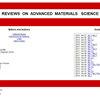用于橡胶机械特性不确定性分析和退化预测的区间模型
IF 3.6
4区 材料科学
Q2 MATERIALS SCIENCE, MULTIDISCIPLINARY
引用次数: 0
摘要
由于橡胶是一种超弹性材料,其在老化过程中的非线性变形行为受到包括材料特性在内的各种因素的显著影响,具有很大的不确定性。现有的橡胶非线性性能退化不确定性预测方法大多基于概率密度函数,需要大量样本才能得到概率分布,工作量大。因此,本研究采用区间模型来表征不确定性。然而,传统的区间构成模型忽略了区间变量之间的相关性,预测结果误差较大。为了尽量减小预测误差,提高预测精度,建立了考虑参数间相关性的区间穆尼-里夫林(M-R)相关模型。为解决不确定性的影响,构建了区间阿伦尼斯模型。M-R 模型需要对应力-应变曲线进行多次拟合才能获得模型参数,预测过程相对复杂。因此,结合所提出的两种模型,首先通过区间阿伦尼斯建立橡胶拉伸应力与老化温度和老化时间的关系式,然后利用区间 M-R 模型得到参数 C 10 {C}_{10} 和 C 01 {C}_{01} 的变化范围。通过与测量的橡胶老化信息对比,证实了所提模型的有效性。与基于平均值的预测模型相比,该模型的最大预测误差降低了约 60%。与传统的区间模型相比,预测区域明显缩小,进一步提高了预测精度。上述结果表明,该区间老化寿命预测模型适用于表征类橡胶弹性体的非线性应力应变行为。本文章由计算机程序翻译,如有差异,请以英文原文为准。
Interval models for uncertainty analysis and degradation prediction of the mechanical properties of rubber
As rubber is a hyperelastic material, its nonlinear deformation behavior during aging is significantly influenced by various factors, including the material characteristics, demonstrating a significant uncertainty. Most of the existing uncertain prediction methods of rubber nonlinear property degradation are based on the probability density function, which requires a large number of samples to obtain the probability distribution and requires a lot of work. Therefore, the interval model is used in this study to characterize the uncertainty. However, the traditional interval constitutive models ignore the correlation between interval variables, and the prediction results have large errors. In order to minimize prediction errors and improve prediction accuracy, an interval Mooney–Rivlin (M–R) correlation model that considers the correlation between parameters was established. To address the influence of uncertainties, an interval Arrhenius model was constructed. The M–R model requires multiple fittings of stress–strain curves to obtain the model parameters, and the prediction process is relatively complex. Therefore, combing the two proposed models, the relationship equations of rubber tensile stress with aging temperature and aging time were first established by interval Arrhenius, and then the interval M–R model was used to obtain the variation ranges of parameters C 10 {C}_{10} and C 01 {C}_{01} . By contrasting this with the measured rubber aging information, the effectiveness of the proposed model was confirmed. Compared with the prediction model based on the average value, the maximum error of prediction of this model is reduced by about 60%. Compared with the traditional interval model, the prediction region is significantly reduced, which further improves the prediction accuracy. The above results indicate that this interval aging lifetime prediction model is suitable for characterizing the nonlinear stress–strain behavior of rubber-like elastomers.
求助全文
通过发布文献求助,成功后即可免费获取论文全文。
去求助
来源期刊

Reviews on Advanced Materials Science
工程技术-材料科学:综合
CiteScore
5.10
自引率
11.10%
发文量
43
审稿时长
3.5 months
期刊介绍:
Reviews on Advanced Materials Science is a fully peer-reviewed, open access, electronic journal that publishes significant, original and relevant works in the area of theoretical and experimental studies of advanced materials. The journal provides the readers with free, instant, and permanent access to all content worldwide; and the authors with extensive promotion of published articles, long-time preservation, language-correction services, no space constraints and immediate publication.
Reviews on Advanced Materials Science is listed inter alia by Clarivate Analytics (formerly Thomson Reuters) - Current Contents/Physical, Chemical, and Earth Sciences (CC/PC&ES), JCR and SCIE. Our standard policy requires each paper to be reviewed by at least two Referees and the peer-review process is single-blind.
 求助内容:
求助内容: 应助结果提醒方式:
应助结果提醒方式:


